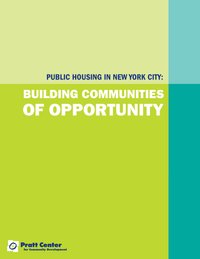“Public Housing in New York City: Building Communities of Opportunity,” provides an in-depth look at the New York City Housing Authority (NYCHA) and the nearly 500,000 New Yorkers who live in its 286 developments. Funded by the Brooklyn Community Foundation, the report outlines strategies that would help create and increase opportunities for public housing residents, nearly half of whom live in poverty.
While NYCHA housing provides essential, affordable housing options, it often results in isolated, impoverished communities. Half of New York City Housing Authority (NYCHA)’s households live in poverty; and, while fewer than 5 percent of all New Yorkers live in public housing, it also houses about 14 percent of the city’s poor. The report asserts that more success would be achieved by forging partnerships between NYCHA and city economic development, transportation and housing agencies, and by connecting residents with jobs created by the development agencies. The recommended partnerships build on existing City initiatives:
- The Department of Small Business Services and Economic Development Corporation’s Targeted Hiring and Workforce Development Program links un- and underemployed job-seekers with training and work opportunities tied to development projects in or near their neighborhoods.
- The planned Department of Transportation and MTA’s citywide Bus Rapid Transit (BRT) can connect far-flung public housing developments to centers of employment and education.
- The existing collaboration between NYCHA and the Department of Housing Preservation and Development to develop NYCHA’s vacant land can be tapped as a source of affordable housing, retail services and resident employment.
Among the report’s other findings:
- Public housing population is shrinking, despite a years’-long waiting list for apartments. Population currently stands at 408,360, a 1.6 percent decline over five years.
- One-third of working-age public housing residents are employed compared with more than half of other city residents.
- Nearly 50 percent of NYCHA residents report that they do not have a high school diploma.
- Average income increased by 39 percent (adjusted for inflation) between 2002 and 2006, to $21,520.
- On average, a NYCHA household spends 28 percent of its income on rent.
- Working-age women outnumber men two-to-one.
- Just 18.5 percent of public housing heads of household were born outside of the United States, in a city in which 41 percent of households are headed by immigrants.
The report—the first of its kind—was made possible by the generous support of the Brooklyn Community Foundation’s Community Development fund, which is devoted to helping stabilize and enhance neighborhoods and workforce development programs.
